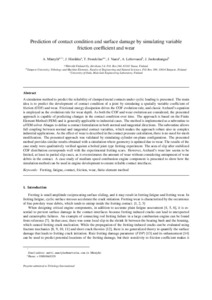Prediction of contact condition and surface damage by simulating variable friction coefficient and wear
Mäntylä, A.; Hintikka, J.; Frondelius, T.; Vaara, J.; Lehtovaara, A.; Juoksukangas, J. (2020)
Mäntylä, A.
Hintikka, J.
Frondelius, T.
Vaara, J.
Lehtovaara, A.
Juoksukangas, J.
2020
106054
Julkaisun pysyvä osoite on
https://urn.fi/URN:NBN:fi:tuni-202101181395
https://urn.fi/URN:NBN:fi:tuni-202101181395
Kuvaus
Peer reviewed
Tiivistelmä
A simulation method to predict the reliability of clamped metal contacts under cyclic loading is presented. The main idea is to predict the development of contact condition of a joint by simulating a spatially variable coefficient of friction (COF) and wear. Frictional energy dissipation drives the COF evolution rule, and classic Archard's equation is employed as the evolution rule for wear depth. As both the COF and wear evolution are considered, the presented approach is capable of predicting changes in the contact condition over time. The approach is based on the Finite Element Method (FEM) and is generally applicable to industrial cases. The method is implemented as a subroutine to a FEM solver Abaqus to define a contact formulation in both normal and tangential directions. The subroutine allows full coupling between normal and tangential contact variables, which makes the approach robust also in complex industrial applications. As the effect of wear is described in the contact pressure calculation, there is no need for mesh modification. The presented approach was validated by simulating cylinder-on-plane configuration. The presented method provides similar results obtained with a simulation where geometry is updated due to wear. The results of the case study were qualitatively verified against a bolted joint type fretting experiment. The area of slip after stabilized COF distribution corresponds well with the experimental fretting scars. However, Archard's wear law seems to be limited, at least in partial slip cases, as it overestimates the amount of wear without considering entrapment of wear debris in the contact. A case study of medium speed combustion engine component is presented to show how the simulation method can be used in engine development to ensure reliable contact interfaces.
Kokoelmat
- TUNICRIS-julkaisut [16951]
